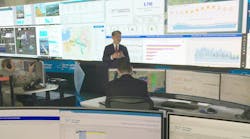Q&A: New York Power Authority CEO Gil Quiniones
In 1882, Thomas Edison built the nation’s first powerplant in Manhattan. Recently in nearby White Plains, New York, the New York Power Authority (NYPA) unveiled its Integrated Smart Operations Center, a state-of-the-art headquarters that uses GE Digital's predictive-analytics software to forecast and prevent equipment failures and significant outages at the NYPA's 16 power plants and 1,400 circuit miles of transmission lines. Online monitoring of power plants, sub-stations and power lines increases plant efficiency and productivity, reduces unplanned downtime, lowers maintenance costs and minimizes operational risks. The technology will help NYPA progress toward meeting their state’s Governor's Clean Energy Standard, which requires that half of all electricity in New York comes from renewable sources and that greenhouse gas emissions be reduced 40% by 2030.
During the opening ceremony, project stakeholders repeatedly expressed admiration for Gil
Quiniones, lauding the NYPA president and CEO’s leadership throughout this massive, ongoing project. Quiniones, while insistent on sharing the credit with his team, was clearly proud of his new digital-control center as he led tours through the facility.
"Deploying these breakthrough technologies marks a major step in NYPA's effort to become the nation's first digital utility, end-to-end, and sets a new standard in utility asset management," he said. "By using advanced data analysis to monitor all our assets simultaneously, we can continue to provide low-cost and reliable power while making smart and efficient operating decisions real time."
We chatted with Quiniones, a member of The Smart Industry 50, to get his unique perspective on the project. Take a look…
Smart Industry: Are large municipal entities like the NYPA tricky to bring into the digital age?
Quiniones: It’s about changing the corporate culture in how we deal with information in this digital age. How do we think more like startup? That should inform the decision-making in our processes, our new products and services. It requires a culture change—that’s the most challenging thing.
Smart Industry: You estimate a billion dollars in savings in ten years. Where do those savings come from?
Quiniones: Increased energy efficiencies, reliability and availability. Also, just capital efficiency. From here on we’re maintaining assets based on actual health rather than cycle times.
Smart Industry: Are we talking about retrofitting legacy equipment or installing greenfield assets?
Quiniones: Many of power plants have SCADA control systems, so we’re getting information from those existing systems by adding sensors and other elements. We’re connecting more equipment into the network while building a high-speed area network to connect all systems in a dedicated way.
Smart Industry: You use the phrase “A more resilient” energy system. What does that mean?
Quiniones: One that can be, in a way, self-healing. We can sectionalize parts of the grid when issues arise. We can reroute power where it is needed during different events.
Smart Industry: What are the differences in application of technology between generation and transmission elements?
Quiniones: It’s all integrated—data analytics and sub-stations, hydro and natural gas. It’s becoming more decentralized, with bi-directional power flows. It’s monitoring the health of those systems in real time, trying to optimize operations and make it all more reliable.
Smart Industry: Your team cites that this digital utility creates new products. What are those products?
Quiniones: Digital twins of customer energy systems is one example. There may be a tech company that comes in and develops software that modulates the performance based on requirements of the grid. The grid can send a signal and the building can receive it. Also, AI and machine-learning are becoming more prevalent.
Smart Industry: What’s your favorite element of this project?
Quiniones: The most cool thing for me is the fact that I see enthusiasm renewed in employees. They are psyched up—excited with all these changes that we’re introducing. They can see tangible results in managing plants and developing new products. It’s an environment where everyone is contributing.




